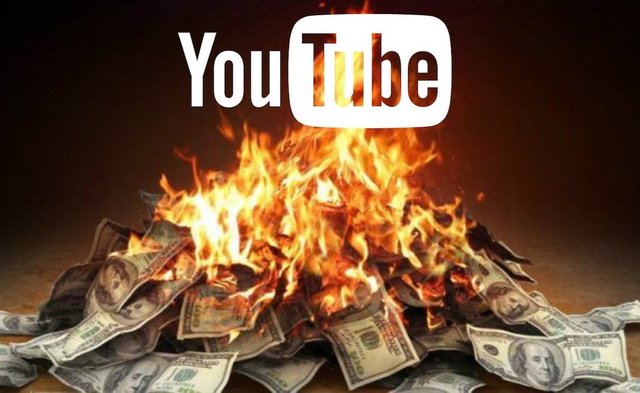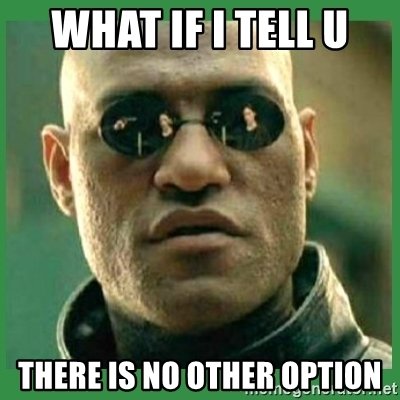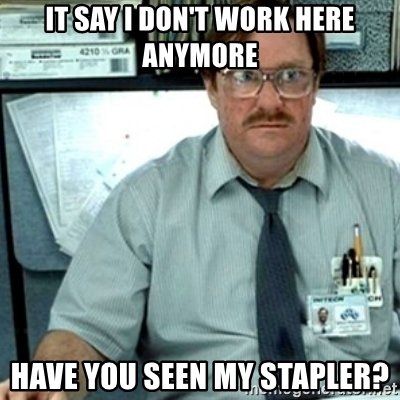
Since the 2016 election, Free-Speech has been under constant assault. Online content is regularly yanked from You-Tube with no rhythm or reason. So far, the Allies who stand in common cause in defense of free-speech and alternative media have managed to hold the line. However, every day is seems like the powers that be are inching closer and closer. Everyday, we lose more soldiers in our fight and still more have their livelihoods destroyed simply for publishing a spicy meme.

Up until this point, our posture in the battle for internet free-speech has been strictly defensive in nature. Alternatives such as Minds, Gab, Bitchute and DTube/Steemit have all been designed with user experience being the primary driver of their design. While this is vital to any viable platform wishing to compete with Youtube, user functionality isn't the reason that YouTube is no longer safe for our forces. Targeting the user experience without focusing on elements necessary to provide the powers that be from pulling the plug or restricting access only delays the enemy's advance. These alternatives act to secure our rear by providing a position for those who are banned from Youtube to retreat and triage without falling into obscurity. However, our enemy, the mainstream media and establishment are not interested in sharing influence over hearts and minds. They believe that they alone are meant to control the flow of information consumed by the public. They are not interest in a peaceful resolution to this conflict and they will stop at nothing to silence each and everyone of us who challenge their narrative. We are being backed into a corner.

While there have been plenty of alternatives being developed as a response to the Ad-pocolayse, none of these alternatives have been able to break the dependency content creators have on those platforms still controlled by the main-stream. The reasons for this are many but it is primarily because the majority of consumers of online content still reside on the platform which has been the main-stay since it became possible for virtually anyone to upload videos to the internet. YouTube remains the defacto standard and. no single alternative offers features like Superchat which many content creators use to earn revenue, especially since massive demonetization began.

So how do we take the fight to our enemy? To quote Sun Szu. "Know your enemy and know yourself, and you shall be victorious. " In line with this wisdom, let's examine the mechanism of capitalism that draws customers with a want and/or need to the products and services that a particular business offers.

In the days before the internet, we used to have something in America called the Better Business Bureau(BBB). As is true today, if a business treated a customers poorly the customer could register a complaint which was typically done with the BBB. in those days any customer looking for a service either had to know the physical location of that business or resort to looking in a telephone book which prominently displayed a businesses BBB rating. Any business that routinely treated it's customers poorly would accumulate more and more complaints and soon find it's BBB Rating downgraded. Because of the relatively closed-loop nature of customer feedback, the BBB served as the gatekeeper between customers and businesses. A business could only continue to mistreat it's customers for so long until the complaints lowered their rating and reduced a business revenue as fewer customers selected that business until eventually that business went bust. This kept the incentive for any business to increase it's bottom line through improved service relative to it's competition rather than reducing expenses at the cost of the consumer.

As the internet became more prevalent, this advertising paradigm went through a metamorphosis. No longer was the telephone book the only efficient means of finding a product or service and customers now could select from a seemingly endless selection of businesses from the comfort of home. However, this door opened both ways. Because it was now possible to reach customers via many different paths and establishing a new web-page was quick and easy, a business could drown out any consumer complaints by simply saturating the channels of of communication. Businesses began to care less about returning customers and more about targeting brand new customers. This meant businesses no longer had an incentive to provide a superior quality service or product as it is traditionally easier to reduce quality. Typically a defect or poor performance was discovered only after a purchase was made and the business had your money. As a result, we have seem the emergence of 'brute-force advertising', where only the largest companies can compete because only they have the capital required to buy enough advertising slots to saturate the market.

While traditional businesses adopted this paradigm of no longer valuing returning customers, new opportunities were presenting themselves over the web. If anyone wishing provide online content had to first secure and solicit companies wishing to advertise before they began ever posting, the entry costs to becoming content creators would remain cost prohibitive. Additionally, companies looking to advertise would have to be provided with some basis that potential consumers would see the advertising slots they purchased. After all, if a website draws no traffic no one will see those advertising slots and the money is wasted. Companies looking to advertise would be too hesitant to sign-on. To solve this conundrum, general purpose advertising entities such as AdSense began selling advertising slots in bulk and offering site providers software that content creators could readily incorporate into their web-page. This allowed the content creator to begin posting content with relatively low overhead and the site provider now had a means of generating a consistent revenue stream.

This advertising paradigm continued up through the creation of YouTube. YouTube made it relatively easy for anyone to post videos online with relatively little technical expertise. As bandwidth and technology improved, all types of creative content began to be posted. As viewership increased, YouTube incorporated mechanisms to automatically integrate advertisements from the pre-purchased pool of advertising slots. These advertising slot could be allocate to any video which appeared on the site and were sold to large companies in bulk by number of views.

When a video is uploaded to YouTube by a content creator, there is very little metadata required to classify this video. This would require each and every video being viewed and cataloged by a YouTube employee. Without such metadata, it is nearly impossible for an algorithm to categorize a video's content. Without such criteria, there is no way to differentiate a video containing say pornography from a video containing the latest official release of a music video. Not only would the addition and verification of metadata on which to filter questionable content be extremely cost prohibitive, there is no financial incentive to provide such metadata.

While it is easy to forget, YouTube is also a business and as such is primarily interested in maximizing revenue. Advertising slots are sold in bulk to companies who wish to advertise their products using these slots are then inserted into videos uploaded by content creators. This is done without any regard to the type of video content which is provided. This creates a potential for the inadvertent association of a video viewed as obscene or offense to be associate with a particular company. Therefore, allowing a video with content that is even the slightest bit controversial to remain in the pool means the potential of embarrassing a potential customer who is paying YouTube to advertise their product. It is therefore, easier for YouTube to simply monitor and remove any content that is even slightly controversial rather the run the risk of a public relations event. Such an event could potential make ANY company hesitant to purchasing further advertising which would not only hurt YouTube's bottom line, but open them up to a lawsuit for damaging their clients brand.

In order to displace the mainstream media from power is by attacking the very mechanism that keeps them in power. Whether it be television, newspapers or magazines, they are all sustained by the same out-dated paradigm: Brute-Force Advertising. Now that we understand the mechanisms by which our enemy operates, we can readily see vulnerabilities and formulate a plan of attack. YouTube is not effected by removing content creators because the advertising slots which their video would draw aren't targeted specifically to the demographics of that viewer. These slots have already been sold and will simply be absorbed by other viewers at random without being subject to spicy memes that might invoke uncontrollable screeching. Saturating the market means they will spend far more money advertising to viewers outside their target demographic. While this is essentially wasting money advertising to consumer who will never consider a product, it has become an acceptable cost because companies have no real alternative and have grown to consider paying for 'brute-force advertising' as a just another cost of doing business.

Now, just suppose it were possible for a company to selectively target various content creators that tend draw audiences which match their desired demographic rather than bulk purchasing wasted advertising slots. We could easily provide required metadata to achieve this resolution by offering viewers tokens to categorize as well as regularly verify this metadata. This capability would provide the companies looking to advertise a more cost-effective alternative than simply random deployment as done currently. Simultaneously, it would allow these companies to be conservative with the types of content with which they would potentially be associated. Further, it would allow small businesses with much less revenue to devout to advertising but a higher tolerance for risk to gain access to advertising now only reserved for the biggest companies. Because there would now be an actual correlation between advertising dollars spent and revenue generated which companies could directly measure, any company who removes their ads due to virtue-signally will lose out to their competition in that same targeted demographic that held their ground. The market would force YouTube, the mainstream media to adapt to the needs of those who provide the cash that keep their businesses running. Any company who continued to utilize the previous brute-force advertising paradigm to propagate censorship would suddenly be spending far more than their competitors....and perish.

It is time to go on the offensive. While I believe the market given time would find the best solution, I don't think we have much time left. The market requires learning from the evolution of various endeavors that came before but that process is rather random and it often takes 3 generations until all requirements can be incorporate. We need to find a solution that both insulates content creators from censorship, allows them readily to earn secure and scale-able income for their work and breaks the choke-hold of the main-stream media over the advertising giants before the government finds an excuse to shut everything down. So this is my proposal:
Crowd-fund the Social Media equivalent of the X-Prize:
Step.1) An effort to pool those participants involved including viewers, content creators and advertises and develop a complete set of requirements and desired features that will meet these objectives.
Step.2) A contest for the team or organization that can develop the best and most robust platform that meets as much of that specification as possible with the best user experience.

Men, I believe we have the beginnings of a battle-plan. Who's with me?!

Please remember to Up-Vote and provide Comments and Feedback.
Only with your support may I continue to contribute to this critical effort!
Congratulations @mananimal! You received a personal award!
You can view your badges on your Steem Board and compare to others on the Steem Ranking
Do not miss the last post from @steemitboard:
Vote for @Steemitboard as a witness to get one more award and increased upvotes!
Downvoting a post can decrease pending rewards and make it less visible. Common reasons:
Submit
Congratulations @mananimal! You received a personal award!
You can view your badges on your Steem Board and compare to others on the Steem Ranking
Vote for @Steemitboard as a witness to get one more award and increased upvotes!
Downvoting a post can decrease pending rewards and make it less visible. Common reasons:
Submit